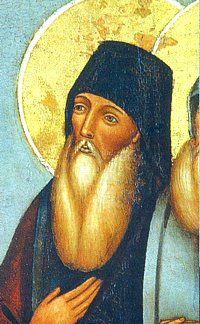
The Monk Irinarkh of Solovetsk accepted tonsure at the Solovetsk monastery, and in his monastic life he zealously imitated the Monks Zosima (Comm. 17 April) and Savvatii (Comm. 27 September). In 1614, after the death of the hegumen Antonii, Irinarkh became his successor. During these times the Solovetsk monastery held tremendous significance in the defense of Northern Russia from the Swedes and the Danes. The new hegumen did much to fortify the monastery. Under the Monk Irinarkh there was constructed a stone wall with turrets, deep ditches dug, and with stones spread out. Concerned about the external dangers to the monastery, the monk also devoted much attention to fortifying it inwardly and spiritually. Very humble and meek, constantly immersed in thought on God, he was zealous for supporting in the monks a true monastic spirit. Under the spiritual guidance of the Monk Irinarkh at the Solovetsk monastery there matured many a worthy ascetic. With the blessing of the hegumen and under his assist, the Monk Eleazar (Comm. 13 January), a friend and co-ascetic of the Monk Irinarkh, founded a skete monastery on Anzersk Island.
In an imperial grammota-document to the Solovetsk monastery in the year 1621, the monks were bidden "to live according to the rules of the holy fathers... and in full obedience to their hegumen (Irinarkh) and the elders".
The last two years of the life of the monk were spent in the exploit of silent prayer.
The saint died on 17 July 1628.

Back

 The Monk Irinarkh of Solovetsk accepted tonsure at the Solovetsk monastery, and in his monastic life he zealously imitated the Monks Zosima (Comm. 17 April) and Savvatii (Comm. 27 September). In 1614, after the death of the hegumen Antonii, Irinarkh became his successor. During these times the Solovetsk monastery held tremendous significance in the defense of Northern Russia from the Swedes and the Danes. The new hegumen did much to fortify the monastery. Under the Monk Irinarkh there was constructed a stone wall with turrets, deep ditches dug, and with stones spread out. Concerned about the external dangers to the monastery, the monk also devoted much attention to fortifying it inwardly and spiritually. Very humble and meek, constantly immersed in thought on God, he was zealous for supporting in the monks a true monastic spirit. Under the spiritual guidance of the Monk Irinarkh at the Solovetsk monastery there matured many a worthy ascetic. With the blessing of the hegumen and under his assist, the Monk Eleazar (Comm. 13 January), a friend and co-ascetic of the Monk Irinarkh, founded a skete monastery on Anzersk Island.
The Monk Irinarkh of Solovetsk accepted tonsure at the Solovetsk monastery, and in his monastic life he zealously imitated the Monks Zosima (Comm. 17 April) and Savvatii (Comm. 27 September). In 1614, after the death of the hegumen Antonii, Irinarkh became his successor. During these times the Solovetsk monastery held tremendous significance in the defense of Northern Russia from the Swedes and the Danes. The new hegumen did much to fortify the monastery. Under the Monk Irinarkh there was constructed a stone wall with turrets, deep ditches dug, and with stones spread out. Concerned about the external dangers to the monastery, the monk also devoted much attention to fortifying it inwardly and spiritually. Very humble and meek, constantly immersed in thought on God, he was zealous for supporting in the monks a true monastic spirit. Under the spiritual guidance of the Monk Irinarkh at the Solovetsk monastery there matured many a worthy ascetic. With the blessing of the hegumen and under his assist, the Monk Eleazar (Comm. 13 January), a friend and co-ascetic of the Monk Irinarkh, founded a skete monastery on Anzersk Island.